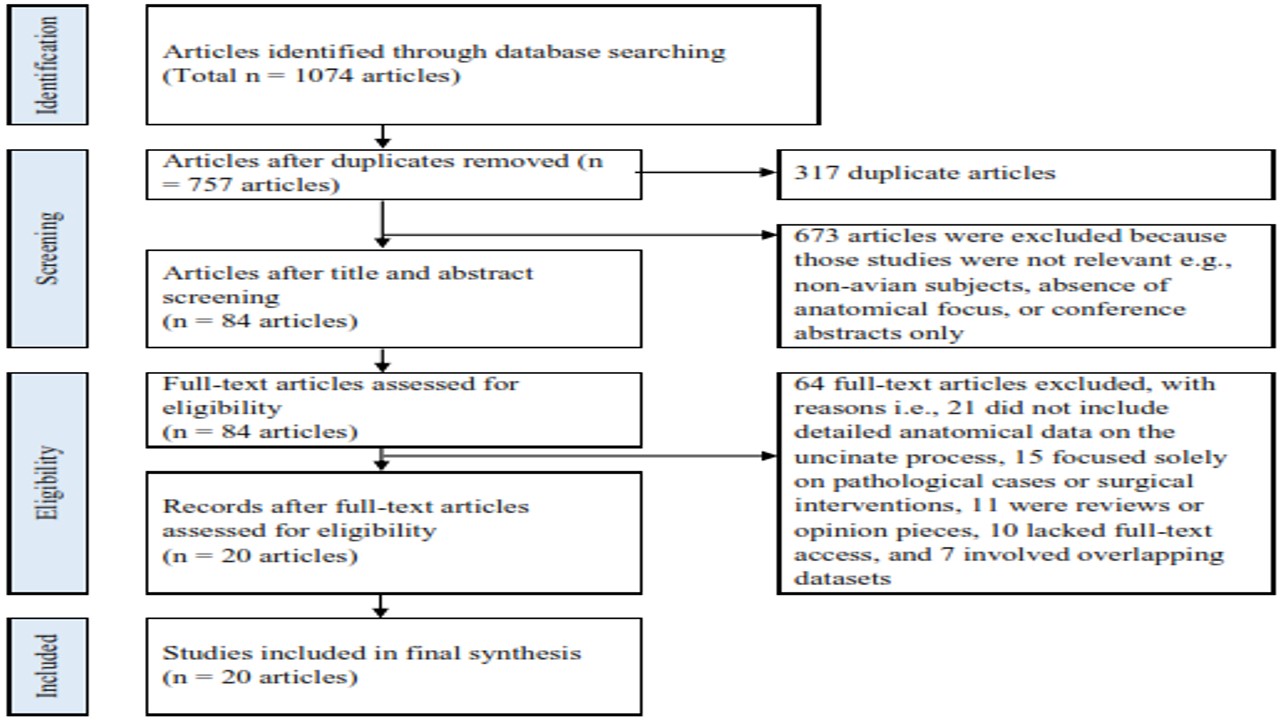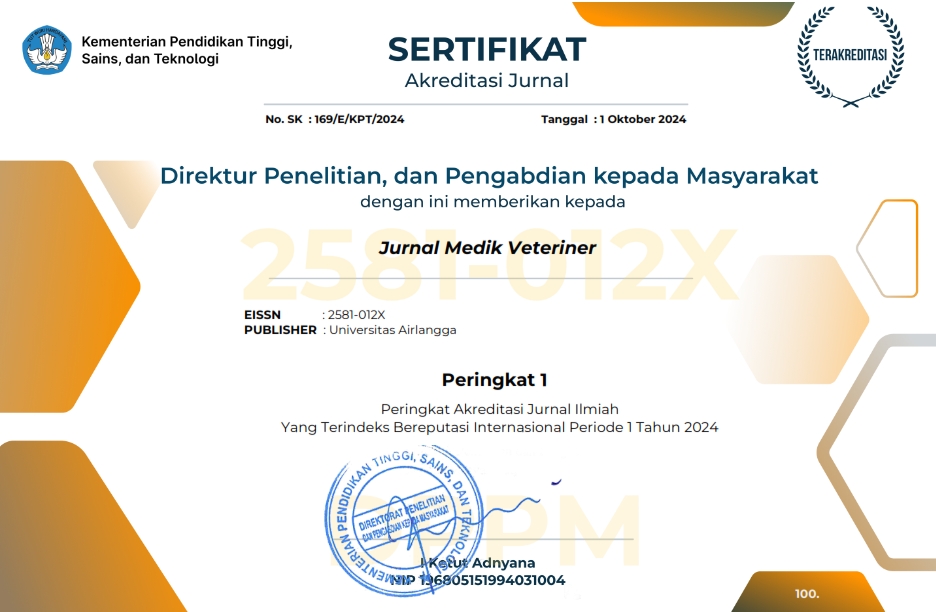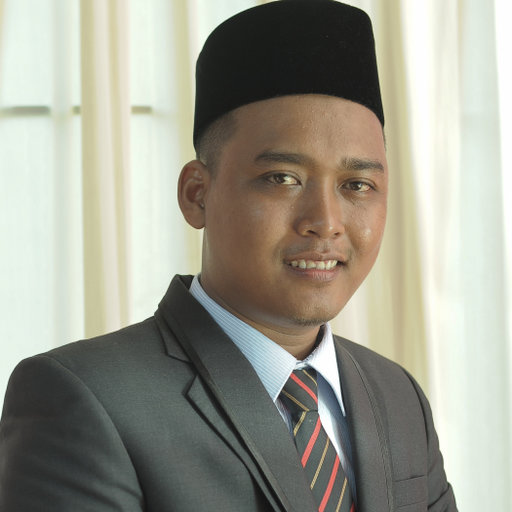Anatomy of the Uncinate Process in Avian: A Literature Review

Downloads
The uncinate process (UP), a dorsocaudal projection from the vertebral ribs, represents a pivotal adaptation in the avian thoracic skeleton, serving as a mechanical brace that enhances respiration and stabilizes the trunk during flight. This literature review synthesizes anatomical, functional, developmental, and evolutionary perspectives on UP morphology across diverse bird taxa. A systematic search spanning 2015–2025 identified 20 relevant studies detailing the structural variability of UPs—categorized as short, intermediate, or long—correlating with flight styles, such as soaring, diving, or terrestrial locomotion. Long UPs, observed in species like penguins and cormorants, are associated with enhanced ventilatory efficiency and thoracic rigidity for high-energy propulsion, while short UPs in flightless birds reflect reduced respiratory demand. Developmental studies reveal ontogenetic shifts from cartilaginous to ossified UPs, aligned with increasing locomotor activity. Evolutionary analysis underscores the UP as a conserved synapomorphy of Aves, with convergent elongation in unrelated taxa emphasizing its functional significance. Structural integration with intercostal musculature and adjacent ribs enables efficient force transmission and thoracic stabilization, vital for maintaining trunk posture during flight. Beyond its evolutionary relevance, UP morphology has practical implications in avian health, surgical ventilation strategies, and bioinspired biomechanical applications. This review highlights the UP as an underappreciated yet essential component of avian musculoskeletal architecture, offering insights into respiratory evolution, ecological adaptation, and comparative vertebrate anatomy. Future investigations should expand morphometric databases and apply high-resolution imaging and biomechanical modeling to further elucidate the functional roles of the UP in avian physiology and evolution.
Baier, D. B., Dial, K. P., & Heers, A. M. (2013). Comparative kinematics of the thoracic skeleton in birds during respiration and flapping flight. Journal of Morphology, 274(6), 749–758.
Bishop, K. L., Codd, J. R., & Tickle, P. G. (2021). Functional implications of uncinate process morphology in birds: Ventilation mechanics and evolutionary adaptation. Biological Reviews, 96(2), 531–547.
Claessens, L. P. A. M. (2009). The evolution of the vertebrate respiratory system. Paleobiology, 35(3), 241–254.
Claessens, L. P. A. M. (2015). Vertebral structure and function in modern and fossil archosaurs. Integrative and Comparative Biology, 55(2), 258–271.
Codd, J. R., Tickle, P. G., & Ennos, A. R. (2015). Mechanics of ventilation in birds: The role of uncinate processes. Zoology, 118(2), 107–116.
Davies, S. J. J. F., & Gosler, A. (2017). Galliformes: Functional Morphology. In del Hoyo, J., Elliott, A., & Christie, D. (Eds.), Handbook of the Birds of the World, 2, 54–69. Lynx Edicions.
Dewi, C. M. S., Dhamayanti, Y., Fikri, F., Purnomo, A., Khairani, S., Chhetri, S., & Purnama, M. T. E. (2024). An investigation of syrinx morphometry and sound frequency association in lovebirds (Agapornis fischeri) chirps. F1000Research, 11, 354.
Dhamayanti, Y., Wahyunita, Z. H., Rantam, F. A., Mafruchati, M., Eliyani, H., Soeharsono, Hendarti, G. A., Palupi, T. D. W., Kinasih, K. N., Rosyada, Z. N. A., Zahro, A. N., & Maslamama, S. T. (2025). Beak morphometrics and line analysis for accurate sex determination in juvenile Lovebird (Agapornis fischeri). Biodiversitas, 26(1), 14–21.
Gray, J. M., & Bertram, J. E. A. (2019). Nocturnal adaptations in the thoracic skeleton of burrowing owls. Journal of Avian Biology, 50(5), e01923.
Hanafi, U. F., Dhamayanti, Y., Purnama, M. T. E., Soeharsono, S., Wibawati, P. A., & Prastiya, R. A. (2021). Hindlimb osteometry of Lohmann broiler on 7, 21 and 35 days. Jurnal Medik Veteriner, 4(1), 23–36.
Jenkins, F. A., Tickle, P. G., & Codd, J. R. (2020). Biomechanics of flight in birds with variable thoracic morphology. Integrative Zoology, 15(3), 292–305.
Kumar, A., Singh, J., & Tyagi, S. (2020). Morphofunctional adaptations in the thoracic region of Ardea alba. Indian Journal of Veterinary Anatomy, 32(1), 11–15.
Kurniawati, D. Y., Puspitasari, Y., Yudhana, A., Saputro, A. L., Dhamayanti, Y., Purnomo, A., Bayram, M., & Purnama, M. T. E. (2024). Sex determination in Japanese quails (Coturnix japonica) based on head morphometry variation among age. Biodiversitas, 25(8), 2740–2748.
Maina, J. N. (2015). The morphostructural features of the avian respiratory system: An evolutionary perspective. Biological Reviews, 90(2), 409–423.
Megawati, N. I., Dhamayanti, Y., Purnama, M. T. E., Soeharsono, S., Yudhana, A., & Yunita, M. N. (2020). The growth patterns of broiler Lohmann strains based on forelimb bone osteometry. Jurnal Medik Veteriner, 3(2), 216–223.
Moore, A. L., Tickle, P. G., & Codd, J. R. (2018). Variation in uncinate process length: Implications for function and ecology. Zoological Journal of the Linnean Society, 183(3), 523–537.
Nabavizadeh, A. (2019). Skeletal morphology and ventilatory function in fossil and extant birds. Journal of Anatomy, 234(3), 398–410.
O’Connor, P. M., & Claessens, L. P. A. M. (2016). Ontogeny of vertebral uncinate processes in modern birds. The Anatomical Record, 299(2), 150–166.
Olsen, B. J., & Madsen, K. M. (2021). Migratory adaptations in crane thoracic skeletons. Ornithological Applications, 123(4), duab042.
Padian, K., & Horner, J. R. (2011). The evolution of “avian” characters in non-avian dinosaurs. Biological Journal of the Linnean Society, 103(2), 173–198.
Schmidt-Nielsen, K. (2010). Animal physiology: Adaptation and environment (5th ed.). Cambridge University Press. pp: 34.
Smith, N. D., & Clarke, J. A. (2020). High-performance flight in swifts and hummingbirds: Skeletal adaptations. Zoological Journal of the Linnean Society, 189(1), 1–21.
Suharsono, D., Dhamayanti, Y., Eliyani, H., Sarmanu, Firdausy, L. W., Maslamama, S. T., & Purnama, M. T. E. (2025). Gross morphology and osteometry of the ribs of Etawah crossbred goats. Biodiversitas, 26(4), 1691–1697.
Tickle, P. G., & Codd, J. R. (2010). Functional morphology of the swan rib cage: Implications for diving performance. Journal of Ornithology, 151(4), 753–759.
Tickle, P. G., Ennos, A. R., & Codd, J. R. (2007). Functional significance of the uncinate processes in birds. Journal of Experimental Biology, 210(22), 3955–3961.
Tickle, P. G., Hutchinson, J. R., & Codd, J. R. (2018). Energy allocation and behaviour in the growing broiler chicken. Scientific reports, 8(1), 4562.
Tickle, P. G., Nudds, R. L., & Codd, J. R. (2012). Uncinate process length in birds scales with resting metabolic rate. PLOS ONE, 7(3), e32229.
Tokita, M., Takeuchi, T., & Kuroiwa, A. (2019). Endocrine regulation of skeletal development in birds: A case study of UP ossification. Developmental Dynamics, 248(1), 72–81.
Töpfer, T., Barthel, P. H., & Fritz, U. (2016). The budgerigar’s thoracic adaptations: A flight-specialist perspective. Avian Biology Research, 9(3), 202–210.
Torres, R., & Brown, M. (2021). Functional reduction of thoracic structures in ratites. Avian Research, 12(1), 17–25.
West, M. J., & Griffin, D. R. (2018). Thoracic skeletal adaptations in wading birds. Waterbird Journal, 41(2), 147–154.
Xu, X., Pittman, M., & Zheng, X. (2022). Early avian thoracic anatomy and the origin of powered flight. Nature Communications, 13(1), 477.
Young, A. R., & Codd, J. R. (2014). Thoracic skeletal development in domestic fowl. Poultry Science, 93(9), 2333–2341.
Zhang, Z., Zheng, X., & Li, Y. (2022). Longitudinal structure-function trends in soaring birds. Avian Biology Research, 15(1), 41–51.
Copyright (c) 2025 Yeni Dhamayanti, Muhammad Suryadiningrat, Aloisius Primo Alvaro, Melina Martupauli Sinaga, Hakan Çalışkan, Lintang Winantya Firdausy

This work is licensed under a Creative Commons Attribution-NonCommercial-ShareAlike 4.0 International License.
Authors who publish in this journal agree to the following terms:
1. The journal allows the author to hold the copyright of the article without restrictions;
2. The journal allows the author(s) to retain publishing rights without restrictions;
3. The legal formal aspect of journal publication accessibility refers to Creative Commons Attribution-NonCommercial-ShareAlike 4.0 International License (CC BY-NC-SA).






11.jpg)




















